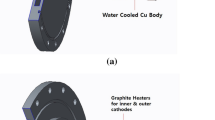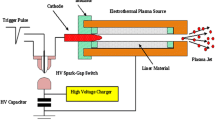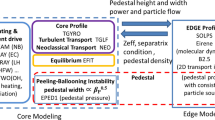Abstract
Because a fusion edge plasma contains various atomic and molecular processes, along with various plasma–material interactions (PMIs) for post-mortem analyses, a linear plasma device can simulate divertor and scrape-off layer (SOL) plasmas with DC edge relevant parameters, although it cannot generate a high ion temperature and toroidicity with much less power density compared to toroidal devices. The Divertor Plasma Simulator-2 (DiPS-2), a linear device with an LaB6 DC cathode, has been used for a few fusion-relevant physics experiments, including edge localized mode (ELM) simulation and edge transport of diffusion and convection. An ELM simulation has been performed by modulating the magnetic field relevant to the pressure modulation of a toroidal device, and the diffusion coefficients of free and bound presheaths have been measured in simulations of divertor or limiter transport. Moreover, the convection of the filament or the bubble expansion to the first wall has also been analyzed. In addition to various atomic and molecular processes in SOL and divertor plasmas, PMIs must be analyzed both on and beneath the surface of the plasma-facing components (PFCs) because of surface modification. Using DiPS-2 and other linear devices along with Korea Superconducting Tokamak Advanced Research (KSTAR), PMIs have been analyzed in terms of the following elements or processes: (1) boronizations, both for dust interactions with the surface chamber (DiSC) and KSTAR device, are analyzed; (2) carbon damage by the dense heat flux of DiPS-2 is experimentally investigated; (3) the density profile of the lithium injection gettering of hydrogen and its transport experiments (LIGHT-1) device is analytically calculated; (4) the effect of nitrogen on the relaxation of the heat flux to the divertor tile is experimentally analyzed; and (5) tungsten as the divertor tile material is analyzed via laser ELM simulations in terms of dust generation and surface modification.





















Similar content being viewed by others
References
G. Federici et al., Nucl. Fusion 41, 1967 (2001)
N. Asakura et al., Nucl. Fusion 44, 503 (2004)
B. Lipschultz, D. Whyte, B. LaBombard, Plasma Phys. Control. Fusion 47, 1559 (2005)
N. Smick, B. LaBombard, C. Pitcher, J. Nucl. Mater. 337–339, 281 (2005)
J.P. Coad et al., Nucl. Fusion 46, 350 (2006)
R.A. Pitts et al., Plasma Phys. Control. Fusion. 47, B303 (2005)
B. Lipschultz et al., Nucl. Fusion 41, 585 (2001)
J. Winter, Plasma Phys. Control. Fusion 46, B583 (2004)
C. Voinier, C.H. Skinner, A.L. Roquemore, J. Nucl. Mater. 346, 266 (2005)
F. L. Guern, et al., R&D on in-vessel dust and tritium management in ITER. in 2011 IEEE/NPSS 24th symposium on fusion engineering SP1–24, 1–5 (2011)
R.A. Causey, J. Nucl. Mater. 300, 91 (2002)
D.M. Goebel, Y. Hirooka, T.A. Sketchley, Rev. Sci. Instrum. 56, 1717 (1985)
Y. Hirooka et al., J. Vac. Sci. Technol. A 8, 1790 (1990)
N. Ohno et al., Nucl. Fusion 41, 1055 (2001)
A. Kreter, Fusion Sci. Technol. 68, 8 (2015)
G.D. Temmerman et al., Fusion Eng. Des. 88, 483 (2013)
J. Rapp, et al., Nucl. Fusion 57 (2017)
H. Liu et al., Fusion Eng. Des. 144, 81 (2019)
K.-S. Chung et al., Fusion Sci. Technol. 63, 16 (2013)
I.J. Kang et al., Curr. Appl. Phys. 17, 358 (2017)
I.J. Kang et al., Plasma Sci. Technol. 22, 045601 (2020)
R.A. Pitts et al., J. Nucl. Mater. 415, S957 (2011)
K.-S. Chung, J. Korean Phys. Soc. 33, 54 (1998)
P.C. Stangeby, The plasma boundary of magnetic fusion devices (IOP Publishing Ltd, Bristol, 2000)
M.-K. Bae et al., Nucl. Mater. Energy 12, 1259 (2017)
J.G. Bak et al., Contrib. Plasma Phys. 53, 69 (2013)
H.-S. Kim et al., Fusion Eng. Des. 109–111, 809 (2016)
J.-H. Sun et al., J. Phys. Soc. 62, 612 (2013)
S.-H. Hong et al., J. Nucl. Mater. 415, S1050 (2011)
H.S. Kim et al., J. Kor. Phys. Soci. 61, 832 (2012)
I.S. Park et al., Sci. Adv. Mater. 13, 2270 (2021)
K.-S. Chung et al., Fusion Eng. Des. 119, 61 (2017)
H. Tsuchiya et al., Fusion Eng. Des. 85, 847 (2010)
S. Ciattaglia, Dust inventory control status in ITER Baseline provisions, R&D plan and first results, in 2nd RCM of IAEA Dust CRP (2010)
J.W. Connor, Plasma Phys. Control. Fusion 40, 531 (1998)
K.-S. Chung et al., Contrib. Plasma Phys. 46, 354 (2006)
R.P. Doerner et al., J. Nucl. Mater. 290, 166 (2001)
I.J. Kang et al., JINST 10, C12019 (2015)
M. Shoji et al., Plasma Phys. Control. Fusion 43, 761 (2001)
J.W. Coenen et al., J. Nucl. Mater. 415, S78 (2011)
G. Pintsuk et al., Fusion Eng. Des. 82, 1720 (2007)
J.W. Coenen et al., Nucl. Fusion 51, 083008 (2011)
A. Huber et al., Phys. Scr. T159, 014005 (2014)
R.A. Pitts et al., Nucl. Mater. Energy 12, 60 (2017)
R.A. Pitts et al., Nucl. Mater. Energy 20, 100696 (2019)
A.W. Leonard et al., J. Nucl. Mater. 266–269, 109 (1999)
R.A. Pitts et al., J. Nucl. Mater. 390–391, 755 (2009)
G.S. Yun et al., Phys. Rev. Lett. 107, 045004 (2011)
A. Kirk et al., Plasma Phys. Control. Fusion 53, 035003 (2011)
N. Asakura et al., J. Phys. Conf. Ser. 123, 012009 (2008)
X.Q. Xu et al., Phys. Plasma 10, 1773 (2003)
Acknowledgements
This research was supported by the National R&D Program through the National Research Foundation of Korea (NRF) funded by the Ministry of Science, ICT and Future Planning (2019M1A7A1A03088471). This research was partially supported by R&D Program of “Plasma Convergence and Fundamental Research (1711124796)” through the Korea Institute of Fusion Energy (KFE) funded by the Government funds, Republic of Korea.
Author information
Authors and Affiliations
Corresponding author
Additional information
Publisher's Note
Springer Nature remains neutral with regard to jurisdictional claims in published maps and institutional affiliations.
Rights and permissions
About this article
Cite this article
Kang, I.J., Bae, MK., Park, I.S. et al. Simulations of fusion edge plasmas by linear plasma devices: physics and plasma–material interactions. J. Korean Phys. Soc. 80, 717–734 (2022). https://doi.org/10.1007/s40042-022-00397-y
Received:
Revised:
Accepted:
Published:
Issue Date:
DOI: https://doi.org/10.1007/s40042-022-00397-y




